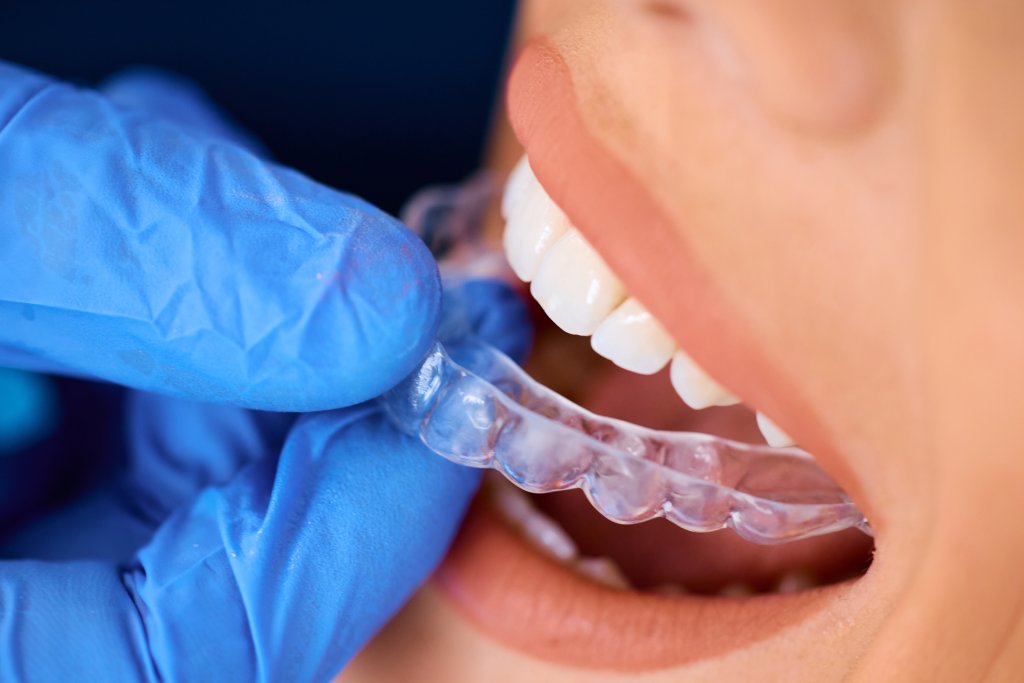Gap dental bonding is an effective and popular solution in cosmetic dentistry to improve your smile by closing small spaces between teeth. This simple and efficient technique helps improve smile aesthetics without the need for more invasive treatments like braces. It’s a quick procedure that’s perfect for individuals with busy schedules, offering a natural and polished look that aligns with your overall dental health goals.
Whether you are seeking to correct chipped teeth, eliminate discoloration, or close gaps, dental bonding offers a versatile solution to suit various needs. The procedure involves applying a tooth-colored composite resin to the affected areas, shaping it to the desired appearance, and hardening it with UV light. This creates a seamless smile makeover that many find life-changing.
As Dr. Marta Milejczyk with years of experience in gap dental bonding and cosmetic dentistry, I invite you to explore how this innovative procedure can improve your smile. With advanced restorative knowledge and a passion for smile changes, I am here to ensure you receive high-quality dental care custom to your needs.
What is Gap Dental Bonding?
Gap dental bonding is a straightforward yet transformative cosmetic dental procedure. It involves using a tooth-colored material called composite resin to fill in small gaps and correct minor imperfections in your teeth. This method is perfect for those seeking a quick smile improvement without the hassle of braces or aligners.
Tooth Bonding
Tooth bonding is a process where a dentist applies the composite resin to your teeth. This material is like a putty that can be shaped and molded to match the natural contours of your teeth. Once applied, it is hardened with a special UV light. This makes the resin durable and gives it a natural appearance.
Composite Resin
The composite resin is the star of the show in gap dental bonding. It’s designed to mimic the natural color and texture of your teeth, ensuring a seamless look. Dentists choose the shade that best matches your teeth, making the bonding virtually invisible. This material is also versatile, used not only for closing gaps but also for fixing chips and covering discolorations.
Minor Imperfections
This procedure is ideal for addressing minor imperfections. If you have small gaps between your teeth or slight chips that affect your smile, gap dental bonding can be a game-changer. It’s a minimally invasive option that provides immediate results, allowing you to walk out of the dentist’s office with a renewed sense of confidence.

By opting for gap dental bonding, you’re choosing a method that improves your smile while maintaining the health and integrity of your natural teeth. It’s a cost-effective and efficient way to achieve the smile you’ve always wanted, without the lengthy process of traditional orthodontics.
How Gap Dental Bonding Works
Gap dental bonding is a simple and effective process that can significantly improve your smile. Here’s how it works:
Adhesive Application
The first step in the bonding process is preparing your teeth. Your dentist will clean the surface of your teeth to ensure the composite resin adheres properly. Then, a conditioning liquid is applied. This liquid acts like an adhesive, helping the resin stick to your teeth securely.
Composite Resin
Next comes the application of the composite resin. This material is carefully selected to match the color of your natural teeth, ensuring a seamless blend. The resin is applied in a putty-like form, allowing the dentist to mold and shape it to fill gaps and correct imperfections. This step is crucial for achieving a natural look and feel.
UV Light Hardening
Once the resin is perfectly shaped, a special UV light is used to harden it. This process is quick, usually taking just a few minutes. The UV light causes the resin to solidify, making it strong and durable. After hardening, the dentist will polish the resin to give it a shiny, tooth-like appearance.

This entire procedure is typically completed in one visit, making it a convenient option for those looking to improve their smile without multiple appointments. The results are immediate, allowing you to leave the office with a brighter, more confident smile.
Gap dental bonding is not only quick but also non-invasive, preserving your natural tooth structure while improving your smile.
Benefits of Gap Dental Bonding
Gap dental bonding offers several advantages that make it a popular choice for many seeking a better smile.
Cost-Effective
One of the main benefits of gap dental bonding is its affordability. Compared to other cosmetic dental procedures, bonding is relatively inexpensive. You can achieve noticeable improvements without breaking the bank. This makes it accessible to a wider range of people who want to improve their smile without a hefty price tag.
Non-Invasive
Gap dental bonding is a non-invasive procedure. This means there’s no need for drilling or removing parts of your natural teeth. The process is gentle and preserves your tooth structure. It’s a great option for those who are nervous about more invasive dental work. Plus, since no anesthesia is typically required, you can avoid the discomfort that sometimes accompanies other dental procedures.
Quick Procedure
The bonding process is fast and efficient. In most cases, it can be completed in a single visit, often in less than an hour. This quick turnaround is perfect for those with busy schedules. You can walk into the dentist’s office with gaps and leave with a beautifully improved smile in just one appointment. The immediate results mean you don’t have to wait weeks or months to see improvements.
Overall, gap dental bonding is a practical and effective solution for closing gaps and improving your smile. It’s an affordable, non-invasive, and quick way to boost your confidence and enjoy a more attractive appearance.
Preparing for Gap Dental Bonding
Getting ready for gap dental bonding involves a few simple steps to ensure the best results. Let’s break down what you can expect before the procedure.
Teeth Cleaning
Before any bonding can occur, your dentist will thoroughly clean your teeth. This step is crucial because a clean surface ensures that the composite resin adheres properly. It also helps in identifying the exact shade of your natural teeth for the next step.
Conditioning Liquid
Once your teeth are clean, the dentist will apply a special conditioning liquid. This liquid gently roughens the surface of your teeth, allowing the composite resin to bond more effectively. Think of it like prepping a wall before painting—it ensures everything sticks just right.
Color Matching
To make sure your bonded teeth look natural, the dentist will carefully select a shade of composite resin that matches your natural tooth color. This color matching is important for a seamless blend, so your bonded teeth look just like the rest of your smile.
By following these preparation steps, your gap dental bonding procedure will be set up for success. You’ll be on your way to a more confident smile in no time!
Longevity and Care for Bonded Teeth
Taking care of your bonded teeth is essential for maintaining their appearance and durability. Let’s explore some simple tips and tricks to keep your gap dental bonding looking great for years.
Dental Care Tips
-
Brush Gently: Use a soft-bristled toothbrush and fluoride toothpaste. Brush in gentle, circular motions to avoid wearing down the composite resin.
-
Floss Daily: Flossing helps remove food particles and plaque between teeth. Be gentle to avoid damaging the bonding.
-
Avoid Hard Foods: Steer clear of biting into hard foods like ice or nuts. These can chip or crack the bonding material.
-
Regular Check-ups: Visit your dentist regularly for cleanings and exams. They can spot any issues early and provide professional cleaning to keep your teeth in top shape.
Lifespan of Bonded Teeth
Bonded teeth can last between 5 to 12 years with proper care. The lifespan depends on your oral hygiene and habits. Avoiding habits like nail-biting or using your teeth to open packages can help extend the life of your bonding.
Maintenance
-
Night Guard: If you grind your teeth at night, consider using a night guard. Grinding can wear down the bonding over time.
-
Avoid Staining Foods: Limit foods and drinks that can stain, like coffee, tea, and red wine. Rinse your mouth with water after consuming these to minimize staining.
-
Repair When Needed: Bonding is not permanent, and damage can occur. If you notice chips or cracks, contact your dentist for a quick touch-up. The good news is that repairs are straightforward and don’t affect your natural teeth.
By following these simple care tips, you can enjoy a healthy and beautiful smile for many years. Now, let’s move on to some frequently asked questions about gap dental bonding.
Frequently Asked Questions about Gap Dental Bonding
How much does gap dental bonding cost?
Gap dental bonding is a cost-effective option for improving your smile. The cost can vary based on factors like location and the extent of the procedure. Typically, prices range from $100 to $400 per tooth. This makes it a more affordable option compared to other cosmetic treatments like veneers. It’s always a good idea to discuss pricing with your dentist to get an accurate estimate for your specific needs.
Is gap dental bonding painful?
The good news is that gap dental bonding is generally a painless procedure. Most patients do not require anesthesia, as the process involves minimal discomfort. The dentist applies a conditioning liquid to the tooth surface, and then the composite resin is molded to fill the gap. If you’re anxious about the procedure, talk to your dentist. They can offer options to help you feel more comfortable.
How long does gap dental bonding last?
With proper care, gap dental bonding can last anywhere from 5 to 12 years. The longevity depends on factors like your oral hygiene habits and lifestyle. Regular dental check-ups and avoiding habits that can damage the bonding, such as biting hard objects, can help extend its lifespan. If the bonding does wear down or chip, repairs are straightforward and can be done quickly without affecting your natural teeth.
By understanding the costs, comfort, and durability of gap dental bonding, you can make an informed decision about whether this treatment is right for you.
Conclusion
When it comes to enhancing your smile with gap dental bonding, choosing the right dental studio is key. At DP Dental Studio, we pride ourselves on creating a welcoming environment that puts you at ease. Our experienced team is dedicated to providing virtually painless treatments, ensuring your comfort throughout the process.
We understand that affordability is a crucial factor in choosing dental care. That’s why we collaborate closely with various insurance providers to maximize your benefits. Our team is committed to helping you steer your insurance options, making gap dental bonding and other cosmetic procedures more accessible.
At DP Dental Studio, every patient is treated like family. We focus on personalized care, tailoring our services to meet your unique needs. Whether you’re looking to close gaps, brighten your smile, or maintain your oral health, we’re here to help you achieve your dental goals.
Experience the difference at DP Dental Studio. Contact us today to learn more about how we can assist you in achieving a healthy, beautiful smile.

